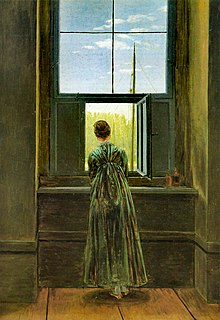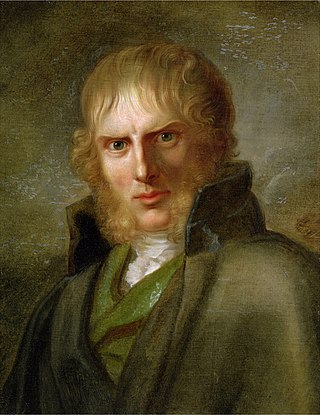
Caspar David Friedrich was a German Romantic landscape painter, generally considered the most important German artist of his generation. He is best known for his allegorical landscapes, which typically feature contemplative figures silhouetted against night skies, morning mists, barren trees or Gothic ruins. His primary interest was the contemplation of nature, and his often symbolic and anti-classical work seeks to convey a subjective, emotional response to the natural world. Friedrich's paintings characteristically set a human presence in diminished perspective amid expansive landscapes, reducing the figures to a scale that, according to the art historian Christopher John Murray, directs "the viewer's gaze towards their metaphysical dimension".

Carl Gustav Carus was a German physiologist and painter, born in Leipzig, who played various roles during the Romantic era. A friend of the writer Johann Wolfgang Goethe, he was a many-sided man: a doctor, a naturalist, a scientist, a psychologist, and a landscape painter who studied under Caspar David Friedrich.

Franz Gerhard von Kügelgen was a German painter, noted for his portraits and history paintings. He was a professor at the Dresden Academy of Fine Arts and a member of both the Prussian and Russian Imperial Academies of Arts. His twin brother, Karl von Kügelgen, was also a painter of note.

Wilhelm Georg Alexander von Kügelgen was a German portrait and history painter, writer, and chamberlain at the Court of Anhalt-Bernburg. He is best known for his posthumously published memoirs, which have gone through many editions from seventeen different publishers.

Wanderer above the Sea of Fog is a painting by German Romanticist artist Caspar David Friedrich made in 1818. It depicts a man standing upon a rocky precipice with his back to the viewer; he is gazing out on a landscape covered in a thick sea of fog through which other ridges, trees, and mountains pierce, which stretches out into the distance indefinitely.
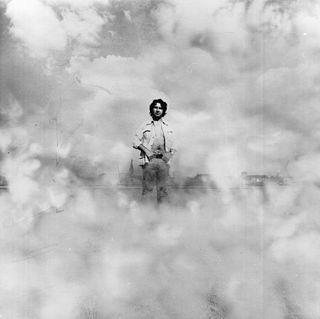
Gotthard Graubner was a German painter, born in Erlbach, in Saxony, Germany.

Georg Friedrich Kersting was a German painter, best known for his Biedermeier-style interior paintings and his association with fellow artist Caspar David Friedrich.

The Stages of Life is an allegorical oil painting of 1835 by the German Romantic landscape painter Caspar David Friedrich. Completed just five years before his death, this picture, like many of his works, forms a meditation both on his own mortality and on the transience of life.
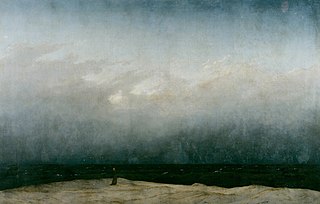
The Monk by the Sea is an oil painting by the German Romantic artist Caspar David Friedrich. It was painted between 1808 and 1810 in Dresden and was first shown together with the painting The Abbey in the Oakwood in the Berlin Academy exhibition of 1810. On Friedrich's request The Monk by the Sea was hung above The Abbey in the Oakwood. After the exhibition, both pictures were bought by king Frederick Wilhelm III for his collection. Today, the paintings hang side by side in the Alte Nationalgalerie, Berlin.
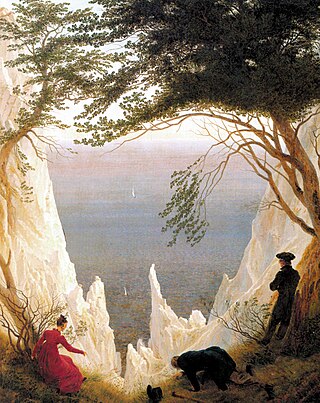
Chalk Cliffs on Rügen is an oil painting of circa 1818 by German Romantic artist Caspar David Friedrich.

The Sea of Ice, (1823–1824), is an oil painting that depicts a shipwreck in the Arctic by the German Romantic painter Caspar David Friedrich. Before 1826 this painting was known as The Polar Sea.
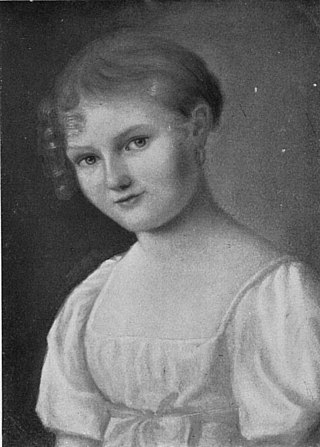
Louise Seidler was a German painter at the court of the grand dukes of Weimar, custodian of their art collection and a trusted friend of the poet Goethe and the painter Georg Friedrich Kersting.
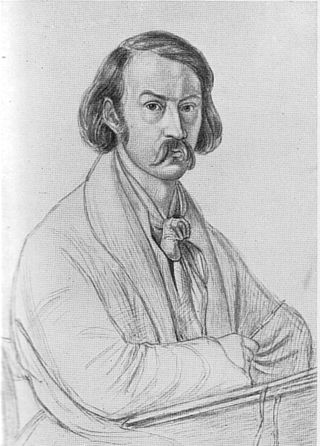
Friedrich Preller the Elder was a German landscape painter and etcher. From 1832 he was a professor at the Fürstlichen freien Zeichenschule in Weimar. He was the father of the artist Friedrich Preller the Younger.

Caroline Bardua was a German painter. She was one of the first middle-class women who was able to create an existence for herself as an independent artist.

Two Men Contemplating the Moon and Man and Woman Contemplating the Moon are a series of similar paintings by Caspar David Friedrich, the setting being among his best-known works. Friedrich painted at least three versions, with one variation featuring a man and a woman. The 1819–20 version in the Galerie Neue Meister is thought to be the original; the c. 1824 variant with a woman is in the Alte Nationalgalerie; and the c. 1830 version is in the Metropolitan Museum of Art.

Cross in the Mountains, also known as the Tetschen Altar, is an oil painting by the German artist Caspar David Friedrich designed as an altarpiece. Among Friedrich's first major works, the 1808 painting marked an important break with the conventions of landscape painting by including Christian iconography. In the hierarchy of genres, religious (history) painting was considered the highest genre of art; Friedrich's use of landscape to evoke a spiritual message was thus controversial, causing debate between proponents of neoclassical ideals and the new German Romanticism of Friedrich and his peers.

Morning on the Riesengebirge is an 1810–1811 painting by the German Romantic artist Caspar David Friedrich of a scene on the Riesengebirge. It was exhibited at the Dresden Academy, where it attracted significant public attention. The painting was then acquired in 1811 by Frederick William III of Prussia for Unter den Linden, his Berlin palace, where it remained until 1837, when it was moved to the New Palace in Potsdam.

Woman at a Window is an 1822 oil painting by the German Romantic artist Caspar David Friedrich. This painting is currently located in Alte Nationalgalerie, Berlin. The painting depicts an interior with a woman, seen from behind, peering out an opened window. Beyond the window, the masts of ships are visible. The woman in the piece is Friedrich's wife Caroline and the view from the window is from his studio overlooking the Elbe river in Dresden. Friedrich submitted his work to be exhibited at the Dresden Academy, however he did not complete the piece in time to be in the main exhibition.

Italia und Germania is an allegorical painting of the painter Friedrich Overbeck, finished in 1828. The painting shows two women inclining to each other, symbolizing the friendship between the two countries or cultures they represent: Italia and Germania. At that time, both Italy and Germany were cultural regions but not unified national states.

Evening is an 1821 oil on canvas painting by Caspar David Friedrich, now in the Niedersächsischen Landesmuseum Hannover. With Morning, Midday and Afternoon, it forms a series on different times of day.


